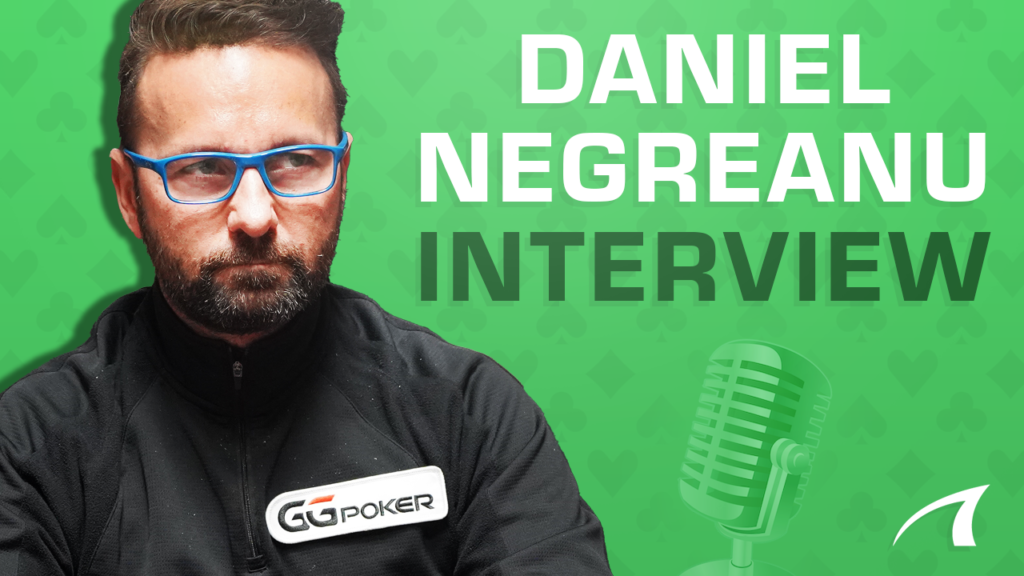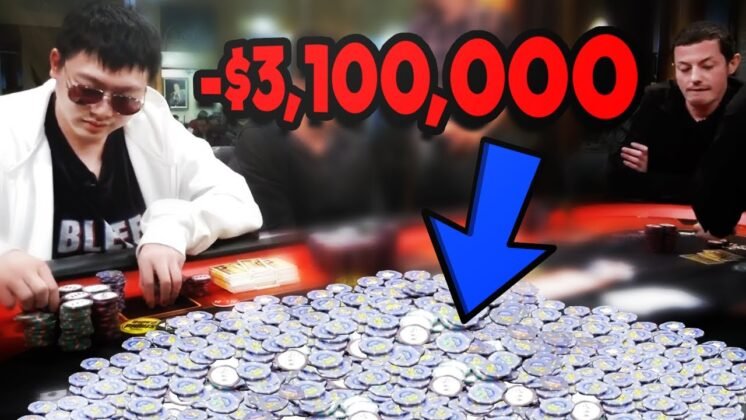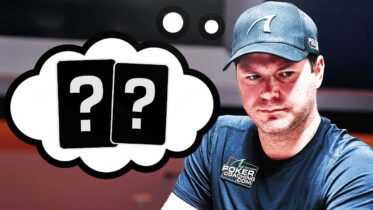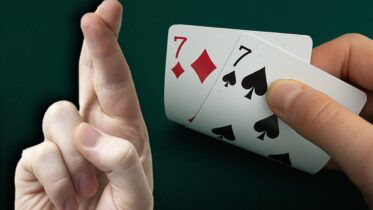As soon as Hustler Casino Live (HCL) owners Ryan Feldman and Nik Vertucci announced that the popular live-streamed poker production would be hosting a Million Dollar Cash Game, poker fans immediately began speculating on whether the record for largest pot in televised poker history would be broken. With each poker player sitting at least $1 million deep, the stakes were indeed high enough to challenge the record held by poker legend Patrik Antonius.
Earlier this year, Antonius appeared in No Gamble, No Future’s own million-dollar game, which resulted in a mammoth pot played between the Finnish pro and fellow high stakes poker player Eric Persson. Catching Persson speeding with the worst hand, Antonius masterfully scooped a $1,978,000 pot, the largest ever in the history of televised poker. While Antonius’ record would remain intact for a few months, it would eventually have to withstand a $1 million buy-in cash game that included the likes of Nik Airball, Doug Polk, and high stakes legend Tom “durrrr” Dwan.
Waking up with pocket queens facing a huge preflop three-bet from HCL fan favorite Wesley, Dwan’s resolve would be tested as the young crypto millionaire barrelled all the way to the river. With an overpair in the biggest pot ever caught on camera, was Dwan able to make the right play?
The Game: $500/$1,000 NLH Cash Game (Stand-Up Game)
Effective Stack: 1,500 Big Blinds
Where: Hustler Casino Live – Los Angeles, California
Tom Dwan, Wesley, and Doug Polk Play The Stand-Up Game on Hustler Casino Live
Throughout the course of the multiple Million Dollar Cash Games hosted by HCL, players at the table frequently participated in the Stand-Up Game. For poker players reading this who are unfamiliar with the Stand-Up Game, the game entails all players standing up at the poker table. Once a player wins a pot, they earn the right to sit down and continue playing. The Stand-Up Game continues until only one player remains standing, who then has to pay each player at the table a certain amount of money.
While some poker players are not fans of the Stand-Up Game, the game variation is a great way to induce action at the poker table. As players remain standing and grow increasingly frustrated, they may make overly aggressive moves that can be exploited. Or, alternatively, their premium holdings can be underrepresented, as other players assume they are trying to earn the right to sit down rather than holding a strong hand.

Wesley and Tom Dwan Build The Pot With Premium Hands Preflop
Following a hijack raise for $7,000 from the player known as LSG Hank, Wesley peered down at A♦-K♥ on the button and kicked it up to $30,000. As if the high stakes didn’t make this hand interesting enough, Doug Polk, who was seated to Wesley’s left, accidentally saw his opponent’s hand and made it known to the table. Although Polk would fold immediately, his involvement would add an interesting layer to this hand’s dynamic.
Sitting in the under-the-gun straddle, Tom Dwan looked down at Q♣-Q♠ and four-bet a staggering $100,000. Facing a large bet from durrrr, Wesley elected not to call, but instead five-bet $275,000. Not going anywhere with his pocket queens, Dwan made the call, making the pot well above half a million dollars before the flop!
Preflop Hand Analysis – Tom Dwan Versus Wesley
With pocket queens out of position, Tom Dwan played a sound strategy by four-betting out of position but then calling the five-bet from Wesley. Although Dwan could certainly have been behind pocket aces or kings, he could also be ahead of other hands in Wesley’s range that take the same line (like A-K).
Facing the $100,000 four-bet from Dwan, Wesley should have flatted rather than make the large five-bet. When you are playing incredibly deep stacked, you do not want to balloon the pot to too big of a size preflop. With the pot already growing to a significant size, Wesley was able to play a premium hand in position against Dwan. Since position provides such a significant advantage, it was not necessary for Wesley to continue adding money to a pot that was already well within six figures.
Regardless, both players contributed to what was becoming a historic pot, and would continue doing battle on the flop.
Tom Dwan’s Pocket Queens See A Safe Flop
The Pot: $562,000
The Board: 8♠-8♦-3♦
Effective Stack: 1,300 Big Blinds
Although Wesley held the ace of diamonds for a runner-runner nut flush draw, Dwan’s pocket queens were still best on what was a relatively safe flop. Following a check from Dwan, Wesley contemplated his next move and asked his opponent how much he had behind, quieting the table. After thinking for some time, Wesley made a $125,000 continuation bet and got the call from Dwan.
Flop Hand Analysis – Tom Dwan Versus Wesley
First to act on the flop, Dwan should be checking his entire range and did exactly that. When checked to, Wesley should continuation bet frequently considering the immense strength he represented preflop. While it was unlikely Dwan would fold, by betting on the flop Wesley can build the pot to eventually apply pressure during later betting rounds. Considering his five-bet preflop, Wesley had to continue representing pocket aces and kings to keep his opponent guessing, which he did with his $125,000 bet. Unless the flush draw came in, pocket aces and kings were strong enough hands to bet all three streets. To properly represent aces and kings to potentially bluff Dwan, Wesley would have to keep firing.
A Blank Card On The Turn
The Pot: $812,000
The Board: (8♠-8♦-3♦)-5♥
Effective Stack: 1,100 Big Blinds
Still holding the best hand, Dwan checked it over to Wesley, who was running out of cards to improve his ace-high. Having no choice but to continue firing, Wesley made another bet, this time for $350,000. After assessing his options, Dwan made the call.
Turn Hand Analysis – Tom Dwan Versus Wesley
While it was perfectly reasonable for Wesley to “slow down” and check back, he held a good bluffing hand considering what it blocked Dwan from having. By holding ace-king offsuit, Wesley blocked his opponent from having premium hands like pocket aces and kings. Along with blocking premium pocket pairs, Wesley also held the A♦. Although Wesley could not hit the nut-flush on the river, he could properly represent it and bluff if another diamond arrived on fifth street.
With his pocket queens serving as a strong overpair on a relatively safe board, Dwan’s only option was to call. While Wesley will sometimes have pocket aces and kings, he will also have plenty of bluffing hands that Dwan could call down. Some recreational players may think Dwan should jam in this spot to prevent his hand from getting outdrawn, but this logic is flawed. By jamming, Dwan would only get called by better and would fail to give Wesley the opportunity to bluff the river.

Wesley Attempts To Bluff Tom Dwan With A Huge River Bet!
The Pot: $1,500,000
The Board: (8♠-8♦-3♦-5♥)-6♣
Effective Stack: 786 Big Blinds
Following a third and final check from Tom Dwan, Wesley knew the only way he could possibly win this pot was if he went for the bluff. After a few moments, Wesley announced all-in, and laid his head down on the table as Dwan entered the tank.
“What the f***” Dwan exclaimed as he pondered his decision. Holding a strong overpair but being forced to play for the remainder of his stack, Dwan contemplated what to do in what was one of the biggest pots of his televised poker career. With how Wesley had played the hand, he could easily have pocket aces or kings to beat Dwan, but the viewers at home knew Dwan had the best of it. In a spot worth $2 million dollars, what was the right play for Dwan to make?
River Hand Analysis – Tom Dwan Versus Wesley
I love this river bluff from Wesley, who truly showed he had the heart of a champion by making this huge bluff worth $786,000. As previously mentioned, Wesley blocked Dwan from holding hands which would, in essence, be automatic calls in this spot. Recognizing the only way he could win the hand was through bluffing, Wesley made the correct play despite the huge amount of money he was risking.
Even though he had the best hand, Dwan was in an incredibly tough spot in what had become one of the biggest pots in televised poker history. To come to the correct decision, Dwan had to consider the pot odds he was being offered before making the call. Considering how much he had to risk compared to what he could potentially win, Dwan would have to win 25% of the time in order for a call to be profitable, but the question was: would Wesley bluff more than 25% of the time in this spot?
Contemplating Wesley’s shoving range, the young player would likely do this with pocket aces and kings, accounting for six combinations of hands. Although Wesley could technically have some combinations containing eights, such hands are unlikely to be five-bet with preflop. While pocket aces and kings account for the value hands in his range, how many combinations of bluffing hands did Wesley’s range contain? There are 16 combinations of ace-king hands in his range, as well as 8 combinations of ace-queen (Dwan blocked two queens). With those combinations along with a smattering of other ace-x combos, there were roughly thirty combinations of bluffing hands in Wesley’s range. With the amount of better hands as well as the number of bluffs Wesley had in his range, he could logically bluff more than 25% of the time.
Facing an opponent who had enough bluffs in their range, Dwan was in a spot where he could profitably call and scoop a historic pot, but even though he had the proper odds, doing so for $786,000 was no easy task. With all of the HCL chat pros anxiously awaiting his decision, was Tom Dwan able to pull the trigger and make televised poker history?
Conclusion: Tom Dwan Wins The Biggest Pot In Televised Poker History
After contemplating for quite some time, Tom Dwan eventually placed a stack of purple chips into the middle, making the correct call in a pot worth over $3,100,000. Upon reveal, Dwan saw that he had once again won the largest pot in the history of televised poker. Despite the financial loss, Wesley, who had drawn heavy criticism for his low VPIP in previous sessions of the Million Dollar Game, silenced his haters by executing one of the largest bluffs ever in the history of poker.
With the success of the Million Dollar Cash Game, Hustler Casino Live not only made more poker history but offered exciting, high stakes poker content for their growing poker fan base. It is hard to debate the fact Hustler Casino Live has become the premier poker production in the industry, and with the ability to organize and air such alluring games at the highest stakes, there is no telling what the team of Feldman and Vertucci will put together next.
A special thank you to Hustler Casino Live for letting us use footage from the Million Dollar Game to review this hand. If you enjoyed this article, be sure to check out our list of the biggest pots and the craziest hands in the history of Hustler Casino Live.



